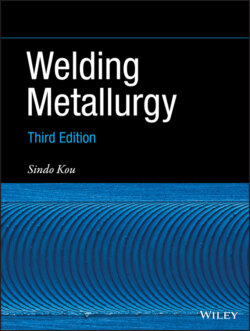Читать книгу Welding Metallurgy - Sindo Kou - Страница 53
1.6.2 Friction Welding
ОглавлениеFriction welding is a solid‐state joining process that joins metals by heating two surfaces through mechanically induced rubbing motion and forcing them against each other. Figure 1.38 shows rotary friction welding (RFW). First, one member of the workpiece is rotated and the other is stationary. When the appropriate rotational speed is reached, the stationary member is forced against the rotating one to cause friction heating to soften the materials at the faying surfaces. This is the rubbing or friction stage, during which the welding heat is developed. After that, the force is increased significantly to squeeze out the softened materials and their oxide films as flash. This is the upsetting or forging stage, during which weld is further heated, the softened materials and their oxide films are squeezed out as flash to allows fresh, oxide‐free materials to bond together. Under the combined action of heating and forging, a hot plasticized layer is formed between the two workpieces in which material mixing occurs. Excessive upsetting results in too big a flash while insufficient upsetting can cause poor bonding.
Figure 1.38 Schematic illustration of rotary friction welding: (a) first piece (axisymmetric) rotating; (b) second piece brought into contact with first piece to cause friction heating; (c) second piece forced against first piece to squeeze materials and oxide films out of the joint area as flash; (d) rotation stopped.
There are two variations of RFW. In direct‐drive (or continuous‐drive) friction welding, the rotating member of the workpiece is directly attached to a motor drive unit to rotate at a constant speed while rubbing against the nonrotating member. The motor is stopped after a predetermined heating time or until a preset axial shortening (called upsetting) occurs. The drive is then disengaged to allow the rotating member to be braked to a stop. In inertia friction welding, on the other hand, the rotating member of the workpiece is connected to a flywheel driven by a motor. After the flywheel is accelerated to the predetermined speed, it is disengaged from the motor. The nonrotating is then pushed against the rotating one until the rotation stops.
There are at least four advantages of RFW:
1 The HAZ is very narrow because the friction is localized at the interface.
2 Dissimilar metals can be welded because there is no melting to cause massive brittle intermetallic compounds to form.
3 Welded joints produced by this process are often as strong as the base metal.
4 The power requirement is low.
There are three disadvantages to friction welding:
1 In general, at least one member of the workpiece must have an axis of symmetry and be capable of being rotated about that axis.
2 Careful preparation and alignment of the members is required to ensure uniform rubbing and heating, particularly with large diameters.
3 Equipment cost is high.
Figure 1.39 shows linear friction welding (LFW). It was developed to use linear reciprocating motion for non‐round parts. One part is set in linear reciprocating motion and the other part, stationary, is forced against it. Again, friction at the interface generates heat to plasticize the material near the faying surfaces, and the applied force squeezes it out as flash (not shown). As an example, the amplitude of vibration is 1–3 mm, the frequency 25–125 Hz, and the axial force 150 kN. By reducing the amplitude of reciprocating motion at the end of the weld cycle to terminate the friction phase, instead of slowing down the frequency, the two parts can be accurately aligned with respect to each other. A well‐known application of linear FSW is the joining of aero‐engine compressor blades to compressor disks, to form blisks [29].
Figure 1.39 Linear friction welding in which a stationary member is forced against a reciprocating member to generate frictional heat to plasticize and remove the material and oxide films near the faying surfaces to cause bonding.
